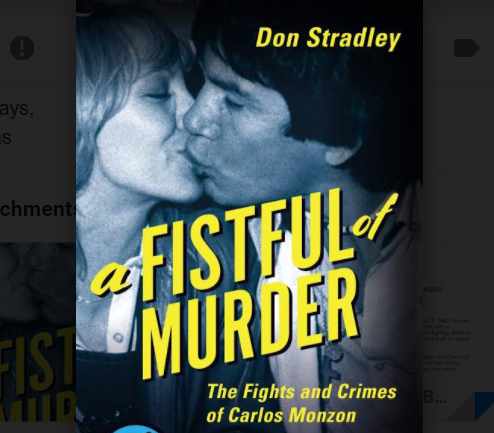Featured Articles
A Fistful of Murder: The Fights and Crimes of Carlos Monzon

Book Review by Thomas Hauser — Carlos Monzon was born into extreme poverty in Argentina on August 7, 1942. He was mean, violent, surly, brutal, arrogant, occasionally charming, handsome with a smoldering sensuality, and remorseless. His life was marked by street fighting, drunken behavior, domestic violence, and more than forty arrests. In the midst of it all, he found boxing.
Monzon’s story is told by Don Stradley in A Fistful of Murder: The Fights and Crimes of Carlos Monzon. It’s the latest in a series of short books from Hamilcar Publications published under the imprint Hamilcar Noir that deal with boxers whose lives were marked and often terminated by violent crime. Told in 128 pages, the story moves at a brisk pace.
Monzon had one hundred professional fights in a career that began in 1962. He reigned as middleweight champion from 1970 until his retirement in 1977 and was honored as the 1972 “Fighter of the Year” by the Boxing Writers Association of America. All told, he compiled an 87-3-9 (59 KOs) record with 1 no contest. The three losses came during the first two years of his career when he was a novice.
Monzon was a big, strong, tough fighter with a good chin and a basic skill set: stand tall, throw a sharp jab, and follow with a hard right behind it. Mark Kram described him as “a perfectly shaped middleweight, tall with long arms and with style running through every sinew up to his dramatic Belmondo face.”
By contrast, British boxing commentator Reg Gutteridge described Monzon as having “little ring grace” and added “he clubs as if wearing a Roman cestus on his fist.”
Those who question Monzon’s greatness point to the fact that the best of the fighters he beat were past their prime (e.g. Nino Benvenuti) or past their prime and naturally smaller men (e.g. Emile Griffith and Jose Napoles). Monzon was also held to a draw by Benny Briscoe before besting Briscoe on a close decision in a rematch. And he only narrowly defeated Rodrigo Valdez in the last two fights of his ring career.
But as Stradley writes, “A strange thing happened to Monzon in retirement. He became a better fighter. The boxer who had often been dismissed as a classless thug was now revered as an all-time great. During the next decade when lists were made of the top middleweights or of great championship reigns, Monzon’s name would always be near the top.”
How good was Monzon?
Hall of Fame matchmaker Bruce Trampler says that he would have been competitive with any middleweight in any era. More significantly, in 2007, I had a conversation with Bernard Hopkins in which I asked Bernard to speculate as to how he would have fared in the ring against Sugar Ray Robinson, Marvin Hagler, and Monzon. Hopkins’ answer is instructive:
“Sugar Ray Robinson at 147 pounds was close to perfect,” Bernard said. “But at middleweight, he was beatable. I would have fought Ray Robinson in close and not given him room to do his thing. He’d make me pay a physical price. But at middleweight, I think I’d wear him down and win. Me and Marvin Hagler would have been a war. We’d both be in the hospital afterward with straws in our mouth. We’d destroy each other. My game-plan would be, rough him up, box, rough him up, box. You wouldn’t use judges for that fight. You’d go by the doctors’ reports. Carlos Monzon? I could lose that fight. Monzon was tall, rangy, did everything right. I see myself losing that fight more than winning it.”
Stradley’s recounting of Monzon’s ring career is largely pro forma. The more compelling portions of the book lie in the portrait he paints of Monzon’s personal life.
Monzon had virtually no formal education and was close to illiterate. At age 19, he married 15-year-old Mercedes Beatriz Garcia. The newly-wed couple lived with her family in a two-room shack where they slept on a mattress on the floor.
“In many ways,” Stradley writes, “Monzon was the typical wife abuser. He was obsessed with control; he had an evil temper; he drank too much.” In 1973, Mercedes shot her husband in the arm and shoulder after a quarrel between them.
Monzon’s pattern of physically abusing women, assaulting people in public, reckless driving, and other anti-social acts was a constant in his life before, during, and after his championship reign. But as his fame grew, so did his following.
“Monzon,” Stradley notes, “didn’t look like other fighters of the day. He was photographed to look like a stylish Latin pop star, usually in a long leather coat, with plenty of gold jewelry. Argentina’s El Grafico [a popular magazine] treated Monzon like a model, featuring him in regular photo spreads.”
In 1974, while married to Mercedes, Monzon met Susana Gimenez (a popular actress and talk show host). Soon, they were involved in a torrid affair that lasted for four years. At one point, Mercedes complained to her husband about Susana and he punched her in the face, breaking the superciliary arch above her eye. Monzon was arrested and avoided a prison term by pleading temporary insanity. A divorce followed.
Susana’s film credits included adult-oriented comedies. In Stradley’s words, “Monzon had abandoned the mother of his children for a slutty clown. It didn’t help that her sartorial sense ran towards pink denim.”
Even so, Stradley recounts, “Monzon and Susana were now the most photographed twosome in Argentina. Journalist Alfredo Serra estimated they appeared on more than three hundred magazine covers, describing the pair as combining ‘the strength, beauty, fame and glamour of the world in a single couple.'”
During his championship reign, Monzon parleyed his fame as a fighter into several film roles. Then he retired; his relationship with Susana ended; and he met Alicia Muniz Calatayud.
Alicia had worked as a model and belly dancer in addition to once managing a hair salon. She and Monzon married in Miami because his divorce from Mercedes wasn’t recognized under Argentine law. They lived together from May 1979 through August 1986 and again during a brief reconciliation in 1987. On several occasions, Alicia filed complaints with the police alleging that Monzon had beaten her.
By 1988, Stradley writes, “Monzon was still famous but no longer important. Most of the time he was drunk.”
On February 14, 1988, during a weekend they were spending together, Monzon murdered his estranged wife.
“Here’s what probably happened,” Stradley posits. “When Alicia came for the weekend, she reminded him that he was late with his monthly payments [for child support]. They returned from their night out, a night where they’d been unfriendly to each other and a witness had seen Monzon hitting Alicia. At some point before 6 a.m., she said something that made the dynamite in his head go off.”
Monzon told conflicting stories after Alicia’s death, all of which centered on the claim that she’d accidentally fallen over a balcony railing during an argument between them. Then an autopsy report revealed that Alicia had been strangled to death.
“Medical examiners,” Stradley recounts, “estimated thirty-five pounds of pressure or more had been applied to Alicia’s throat. Strangling only requires eleven pounds. They estimated it had been done with a two-fingered grip, probably thumb and forefinger in a kind of one-handed death clamp. It takes only twenty seconds or so to strangle someone into unconsciousness. The damage to Alicia’s throat would take much longer. It wasn’t done by accident or in the heat of the moment. It took a few minutes of full-on rage. Alicia had been strangled long after she had passed out. It’s also rare that a strangling victim has visible marks on the neck or throat. The imprints on Alicia were clear and deep, as if someone had tried to squeeze her head off at the neck. He dumped her body over the balcony to make it look like she’d fallen.”
Monzon was charged with murder. The trial was broadcast live on radio throughout Argentina. Monzon testified that he and Alicia had argued about money and admitted that he had slapped her. “I have hit women on other occasions and nothing happened to any of them,” he told the court. “I hit all of my women except one. My mother.”
A three-judge panel found Monzon guilty of murder. He was sentenced to eleven years in prison with the possibility of time off for good behavior.
By 1993, Monzon was allowed to spend daytime hours and weekends outside of prison. On Sunday, January 8, 1995, after attending a barbeque, he was behind the wheel of a car, probably drunk and definitely speeding.
“By the rules of his furlough agreement,” Stradley writes, “he had to be back at the Las Flores prison by 8 p.m. He didn’t want to risk being late. He only had a short time left to serve on his sentence and didn’t want any infractions on his record. So he drove fast. He’d always been a terrible driver. Being in prison hadn’t made him any better at it.”
While speeding back to the prison, Monzon lost control of the vehicle which turned over multiple times, killing him instantly. Two other passengers also died in the accident. He was 52 years old.
After Monzon’s death, his body lay in state at City Hall in his hometown of Santa Fe. An estimated ten thousand people filed past it. Twenty thousand more lined the route to the Municipal Cemetery while six thousand mourners waited at the cemetery entrance.
Argentine president Carlos Menem told the nation. “Remember Carlos Monzon as a champion, not as a man jailed for murder.” But Argentinian journalist and political commentator Bernardo Neustadt took a contrary view, declaring, “We are a macho society that idolizes a man who beats or violates a woman; a macho society that taught Monzon to dress up, to speak a bit better, but didn’t teach him to think; a macho society that wasn’t horrified when Monzon said he beat all his women.”
Thomas Hauser’s email address is thomashauserwriter@gmail.com. His next book – Staredown: Another Year Inside Boxing – will be published by the University of Arkansas Press this autumn. In 2004, the Boxing Writers Association of America honored Hauser with the Nat Fleischer Award for career excellence in boxing journalism. He will be inducted into the International Boxing Hall of Fame with the Class of 2020.
Check out more boxing news on video at the Boxing Channel
To comment on this story in the Fight Forum CLICK HERE
-

 Featured Articles3 weeks ago
Featured Articles3 weeks agoVito Mielnicki Jr Whitewashes Kamil Gardzielik Before the Home Folks in Newark
-

 Featured Articles4 days ago
Featured Articles4 days agoResults and Recaps from New York Where Taylor Edged Serrano Once Again
-

 Featured Articles1 week ago
Featured Articles1 week agoFrom a Sympathetic Figure to a Pariah: The Travails of Julio Cesar Chavez Jr
-

 Featured Articles3 days ago
Featured Articles3 days agoResults and Recaps from NYC where Hamzah Sheeraz was Spectacular
-

 Featured Articles4 weeks ago
Featured Articles4 weeks agoCatching Up with Clay Moyle Who Talks About His Massive Collection of Boxing Books
-

 Featured Articles1 week ago
Featured Articles1 week agoCatterall vs Eubank Ends Prematurely; Catterall Wins a Technical Decision
-

 Featured Articles4 days ago
Featured Articles4 days agoPhiladelphia Welterweight Gil Turner, a Phenom, Now Rests in an Unmarked Grave
-

 Featured Articles3 weeks ago
Featured Articles3 weeks agoMore Medals for Hawaii’s Patricio Family at the USA Boxing Summer Festival



















